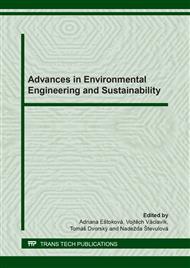[1]
Ch.F. Ferraris, J.M. Gaidis, Connection between the rheology of concrete and rheology of cement paste, Mater. J., 89.4 (1992) 388-393.
Google Scholar
[2]
P. Hewlett, M. Liska (ed.), Lea's chemistry of cement and concrete, fifth ed., Oxford, Butterworth-Heinemann, (2019).
Google Scholar
[3]
F.J. Rubio-Hernández, Rheological Behavior of Fresh Cement Pastes, Fluids. 106 (2018) 1-16.
DOI: 10.3390/fluids3040106
Google Scholar
[4]
D. Feys, et al., Measuring rheological properties of cement pastes: most common techniques, procedures and challenges, RILEM Tech. Lett. 2 (2017) 129‐135.
DOI: 10.21809/rilemtechlett.2017.43
Google Scholar
[5]
S. Hanehara, K. Yamada, Rheology and early age properties of cement systems, Cem. Conc. Res. 38.2 (2008) 175-195.
DOI: 10.1016/j.cemconres.2007.09.006
Google Scholar
[6]
S.M. Mansour et al., Improvement of Rheological behaviour of Cement Pastes by Incorporating Metakaolin, Eur. J. Sci. Res. 42 (2010) 442-452.
Google Scholar
[7]
L. Dong, M.S. Choi, Standard Reference Materials for Cement Paste, Part I: Suggestion of Constituent Materials Based on Rheological Analysis, Mater. 624 (2018) 1-12.
DOI: 10.3390/ma11040624
Google Scholar
[8]
D. Li et al, Investigation of rheological properties of fresh cement paste containing ultrafine circulating fluidized bed fly ash., Constr. Build. Mat. 188 (2018) 1007-1013.
DOI: 10.1016/j.conbuildmat.2018.07.186
Google Scholar
[9]
Y. Qian et al., Effect of polycarboxylate ether superplasticizer (PCE) on dynamic yield stress, thixotropy and flocculation state of fresh cement pastes in consideration of the Critical Micelle Concentration (CMC), Cem. Conc. Res. 107 (2018) 75-84.
DOI: 10.1016/j.cemconres.2018.02.019
Google Scholar
[10]
J. Zhang et al., Effects of superplasticizer on the hydration, consistency, and strength development of cemented paste backfill, Minerals. 381 (2018) 1-13.
DOI: 10.3390/min8090381
Google Scholar
[11]
H. Sada, M. Fall, Time-and temperature-dependent rheological properties of cemented paste backfill that contains superplasticizer. Pow. Tech. (2019).
DOI: 10.1016/j.powtec.2019.09.025
Google Scholar
[12]
J.H. Kim et al., Rheology of cement paste under high pressure, Cem. Conc. Comp. 77 (2017) 60-67.
Google Scholar
[13]
L. Dong, M.S. Choi, Standard Reference Materials for Cement Paste: Part II-Determination of Mixing Ratios, Materials. 861 (2018) 1-12.
DOI: 10.3390/ma11050861
Google Scholar
[14]
L. Dong, M.S. Choi, Standard Reference Materials for Cement Paste: Part III—Analysis of the Flow Characteristics for the Developed Standard Reference Material According to Temperature Change, Materials. 2001 (2018) 1-11.
DOI: 10.3390/ma11102001
Google Scholar
[15]
H. Huang et al., Temperature dependence of structural build-up and its relation with hydration kinetics of cement paste, Constr. Build. Mat. 201 (2019) 553-562.
DOI: 10.1016/j.conbuildmat.2018.12.226
Google Scholar
[16]
M.A. Gajewicz-Jaromin et al., Influence of curing temperature on cement paste microstructure measured by 1H NMR relaxometry, Cem. Conc. Res. 122 (2019) 147-156.
DOI: 10.1016/j.cemconres.2019.05.002
Google Scholar
[17]
M.V. John et al., Rethinking cement standards: Opportunities for a better future, Cem. Conc. Res. 124 (2019) 1-18.
Google Scholar
[18]
R. Figmig, A. Estokova, Study of temperature influence of cement and water on the fresh cement paste consistency, IOP Conf. Ser.: Mater. Sci. Eng. 549 (2019) 1-5.
DOI: 10.1088/1757-899x/549/1/012031
Google Scholar
[19]
Information on http://crhslovakia.com/cement/sedy-volne-lozeny-cement/.
Google Scholar
[20]
EN 197-1: 2011 Cement - Part 1: Composition, specifications and conformity criteria for common cements.
Google Scholar
[21]
EN 196-3: 2017 Methods of testing cement – Part 3: Determination of setting times and soundness.
Google Scholar


